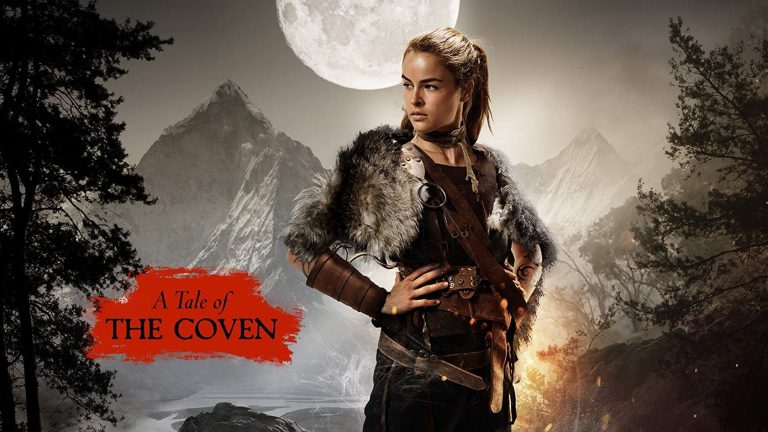Exploring Shades of Gray in R. A. Salvatore’s Song of the Risen God
Who are the good guys & who are the bad guys in Song of the Risen God? We break down the nuanced morality in R.A. Salvatore's trilogy-ender.

This post is sponsored by Tor Books.
Readers who have been following R. A. Salvatore’s career since his early days and the introduction of his iconic character Drizzt Do’Urden, know that the author has never followed a clear path that defines good and evil. In his most recent novel, Song of the Risen God (the conclusion to “The Coven” trilogy), Salvatore doubles down on the idea that both good and evil can be found among any group of people—and that even those striving toward what they believe is “good” will find themselves at odds with others doing the same.
Although Song of the Risen God is the 14th novel set in Corona, it stands on its own remarkably well. It launches like a good old-fashioned dungeon crawl, while also introducing two of the pivotal (and likable) characters of the novel: Brother Thaddius and Sister Elysant, two monks of the Abellican Church, discovering treasures of their religion in a long-hidden tomb.
Thaddius draws on the magic of the holy Ring Stones of his church, while Elysant performs sophisticated and powerful martial arts with her staff to ward off the bandits threatening them. When they face the wraith of a long-ago saint, they accept his blessing rather than seeking to destroy the undead—showing a wisdom frequently lacking among sword-and-sorcery heroes and role-playing gamers alike. It puts the Abellican Church in a good light to begin with these characters. Clearly, this is the group we’re meant to identify with… Or is it?
Soon, we read a letter from Ag’ardu An’grian, an unknown writer with an unknown master, whose identity isn’t uncovered until the very end of the book. Through this writer, who takes a neutral and multi-perspective position, we learn of the struggle between the xoconai, a people who serve the god Scathmizzane, and the humans, whom the xoconai believe serve the demon Cizinfozza. This puts the xoconai in the light of the conquerors, but we understand that if Ag’ardu An’grian can view humans as people, perhaps the xoconai are not needlessly evil.
And then we meet Aoleyn, possibly the most powerful magic user in the world, who defeated a demon and who would have burned her own people, the Usgar—a people who had violated and controlled her—if the xoconai had not done it for her. While Aoleyn is sympathetic, and clearly fighting for the good of her friends, if not the world, there’s no question that she rejects the culture from which she came, even while using the power she learned from within that culture.
All of this happens by the end of the first chapter, and already, an understanding of who is good and who is evil is completely up in the air. The Usgar with their slave-taking and patriarchal ways are apparently no loss to the world, but are the xoconai any better? The Abellicans, who seem to be a force for good in the world, frequently hold disdain for their female members, no matter how fierce and competent Sister Elysant is.
The elves, who teach rangers to care for the world and appear to have a strong moral code about the good of the world, choose inaction rather than helping any side in this war. The xoconai believe that anyone who doesn’t obey their living god is a heretic whose death serves to power their holy magic, but the Abellicans also believe that outsiders who use the sacred stones of their religion are somehow demonic, and it takes time for Aoleyn to gain their respect and understanding.
Among the dominant human cultures, the clear structure of power is with men at the top. Their feudal kingdoms, even with benevolent rulers, have little in the way of upward mobility for anyone not born to noble families—something one of the kings seeks to change, but change is slow in coming. The xoconai, on the other hand, are egalitarian among genders, and their political leaders are determined through democratic elections on a two-year cycle. If the xoconai weren’t brutally conquering the human lands and sacrificing humans to their god, they’d seem like the better option. But Salvatore prevents readers from ever being able to take the easy road to right and wrong.
Instead, he relies on his protagonists, who keep their minds open and keep their morals pointed unequivocally toward mercy and understanding, to guide readers through the uncertainty of the world. He allows secondary characters full of their own preconceptions about right and wrong to grow and change, becoming surprising allies for the protagonists.
Occasionally, the line between antagonist and protagonist is quite thin, and only the end of the novel shows which characters are on the right side of history (even then, with a certain amount of ambiguity). It helps, of course, that there’s a healthy dose of swashbuckling and a delightful system of magic—which the characters, particularly Aoleyn, use to wonderfully dramatic effect—to move the story forward.
Given the scope of the novel and the sheer number of characters and points of view that Salvatore uses, it could become easy to lose track of some of the subplots, but instead, Salvatore seeds them successfully throughout, so that when the threads of story come together, the characters are all in the places where they need to be.
While there are many men who drive the story forward, it’s also refreshing how many female characters are at the center of events. In the final confrontation of the novel, the characters who make the critical decision choosing the path of the world are women.
While I’ll admit a soft spot in my heart for Cattie-Brie, one of Salvatore’s major female characters in his Drizzt books, I was truly impressed by the growth in portrayal of his female characters since those early books; they’re complexly drawn with rich inner lives. Likewise, his worldbuilding, in a world he created without direction from a game publisher, is likewise richer. While it maintains the high fantasy flavor that made his works in the Forgotten Realms so popular, there’s a sense in Corona of an investment in this original world and its history that’s deeper.
Song of the Risen God is absolutely a novel in keeping with Salvatore’s legacy of exploring those gray areas between good and evil—and finding good within a people where only evil is expected. But it’s also a work that shows how Salvatore has grown and developed as a writer over his long career. With this trilogy concluded, it will be exciting to see where his next project will take him… and us.
Song of the Risen God is available to purchase wherever books are sold.
